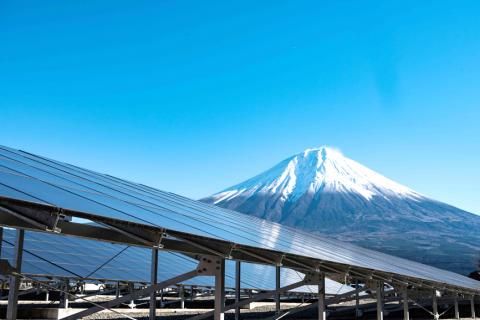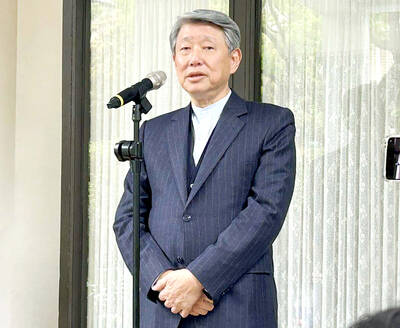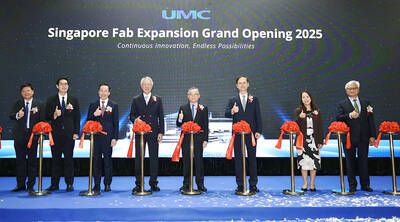The sun is setting on Japan’s clean energy boom, despite projects like a massive floating solar farm near Tokyo, as the government cuts subsidies and bets on nuclear and coal-fired power, critics say.
Workers at the floating power station, one of the world’s biggest, have just finished laying about 50,000 interconnected panels on a vast dam reservoir.
Taking up space equivalent to several Tokyo Dome-sized baseball stadiums, the vast carpet of panels would supply power to about 5,000 homes from early 2018.

Photo: AFP/Solar Frontier Company
The project is the centerpiece of a solar-dominated wave of “renewable” energy investments that followed the 2011 Fukushima Dai-ichi nuclear disaster.
The accident forced the shutdown of reactors that had supplied about one-quarter of resource-poor Japan’s energy.
To plug the gap, electricity providers have been obliged since 2012 to buy power generated from “green” suppliers, including solar, at above-market rates — known as feed-in tariffs — fixed by the government each year.
However, “renewable” energy investments have plateaued and are set to fall in the coming years as Tokyo cuts back subsidies while commodities including coal, oil and natural gas remain cheap.
Japan is also facing a shortage of land for new solar installations.
Kyocera, which is behind the floating farm south of Tokyo, is building a solar plant on an abandoned golf course.
“Several dynamics in the Japanese power sector have shifted since [2012] — such as weakening government support, cheaper fuel alternatives and electricity sector reform — which have all contributed to the slowdown in growth,” BMI Research said in a report.
Some say Japan’s solar potential sits squarely on the roofs of millions of homes.
“There is still a big potential for the Japanese market,” said Atsuhiko Hirano, head of Solar Frontier, a unit of Japanese oil giant Showa Shell. “Utility-scale projects have been the driver so far. In contrast, the residential market has not grown so much. So there is still much more area where we can grow... We are pushing the government to go further.”
Solar accounts for a small fraction of Japan’s energy mix — 3.3 percent last year.
However, Tokyo has said it wants renewables — also including hydro and wind power — to account for 22 to 24 percent of the total by 2030.
However, critical government support appears to be waning as Tokyo drives a push to restart mothballed atomic reactors — an unpopular move among the nuclear-wary public.
The pro-nuclear drive is supported by utilities, which complained about being forced to buy and distribute subsidized power, especially with oil and natural gas prices at multi-year lows.
Japan is also raising eyebrows with plans to invest billions of US dollars at home and abroad in new power plants fired by cheap coal — even as it calls for more “green” power at home.
That includes half a dozen large coal-fired power stations within about 100km of Tokyo, which Greenpeace has branded “simply insane” over health concerns posed by air pollution.
Coal is also the biggest climate change culprit, generating more carbon pollution per unit of energy generated than oil or gas.
Within the G7 club of rich nations, Japan is alone in investing heavily in coal-fired energy on its own soil, with more than 40 new power plants in the pipeline.
That sets it apart from even big polluters, such as China and India, which are pushing away from coal-fired power — although US president-elect Donald Trump has vowed to bring back coal and refocus US energy policy on fossil fuels.
“Japan is betting its economy and energy security on risky coal investments,” said Taylor Dimsdale, Washington-based head of research at energy think-tank E3G.
“The coal development pipeline in the rest of the G7 countries has dried up with no further plants expected beyond a handful of projects that are already under construction.”
Critics say they do not have much hope for Tokyo’s long-term commitment to “renewable” energy.
“After the Fukushima disaster there was an infatuation with ‘renewable’ energy and the government was clearly pressing the accelerator,” said Kimiko Hirata, international director for the Japanese non-governmental organization Kiko Network. “However, since then, I feel like it’s putting the brakes on that policy and concentrating its focus on revising nuclear power and building new coal-fired power plants.”

MULTIFACETED: A task force has analyzed possible scenarios and created responses to assist domestic industries in dealing with US tariffs, the economics minister said The Executive Yuan is tomorrow to announce countermeasures to US President Donald Trump’s planned reciprocal tariffs, although the details of the plan would not be made public until Monday next week, Minister of Economic Affairs J.W. Kuo (郭智輝) said yesterday. The Cabinet established an economic and trade task force in November last year to deal with US trade and tariff related issues, Kuo told reporters outside the legislature in Taipei. The task force has been analyzing and evaluating all kinds of scenarios to identify suitable responses and determine how best to assist domestic industries in managing the effects of Trump’s tariffs, he

TIGHT-LIPPED: UMC said it had no merger plans at the moment, after Nikkei Asia reported that the firm and GlobalFoundries were considering restarting merger talks United Microelectronics Corp (UMC, 聯電), the world’s No. 4 contract chipmaker, yesterday launched a new US$5 billion 12-inch chip factory in Singapore as part of its latest effort to diversify its manufacturing footprint amid growing geopolitical risks. The new factory, adjacent to UMC’s existing Singapore fab in the Pasir Res Wafer Fab Park, is scheduled to enter volume production next year, utilizing mature 22-nanometer and 28-nanometer process technologies, UMC said in a statement. The company plans to invest US$5 billion during the first phase of the new fab, which would have an installed capacity of 30,000 12-inch wafers per month, it said. The

Taiwan’s official purchasing managers’ index (PMI) last month rose 0.2 percentage points to 54.2, in a second consecutive month of expansion, thanks to front-loading demand intended to avoid potential US tariff hikes, the Chung-Hua Institution for Economic Research (CIER, 中華經濟研究院) said yesterday. While short-term demand appeared robust, uncertainties rose due to US President Donald Trump’s unpredictable trade policy, CIER president Lien Hsien-ming (連賢明) told a news conference in Taipei. Taiwan’s economy this year would be characterized by high-level fluctuations and the volatility would be wilder than most expect, Lien said Demand for electronics, particularly semiconductors, continues to benefit from US technology giants’ effort

‘SWASTICAR’: Tesla CEO Elon Musk’s close association with Donald Trump has prompted opponents to brand him a ‘Nazi’ and resulted in a dramatic drop in sales Demonstrators descended on Tesla Inc dealerships across the US, and in Europe and Canada on Saturday to protest company chief Elon Musk, who has amassed extraordinary power as a top adviser to US President Donald Trump. Waving signs with messages such as “Musk is stealing our money” and “Reclaim our country,” the protests largely took place peacefully following fiery episodes of vandalism on Tesla vehicles, dealerships and other facilities in recent weeks that US officials have denounced as terrorism. Hundreds rallied on Saturday outside the Tesla dealership in Manhattan. Some blasted Musk, the world’s richest man, while others demanded the shuttering of his